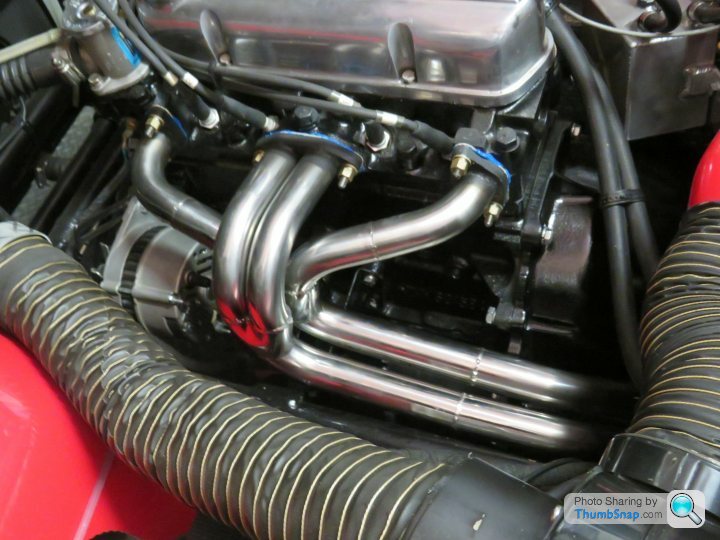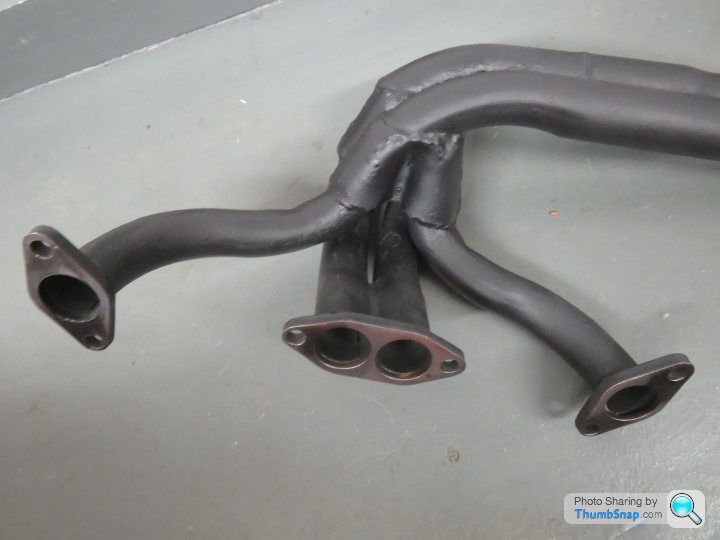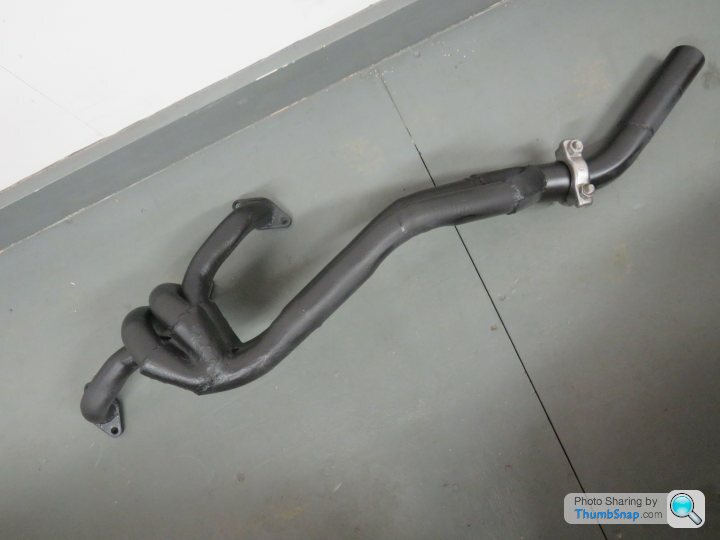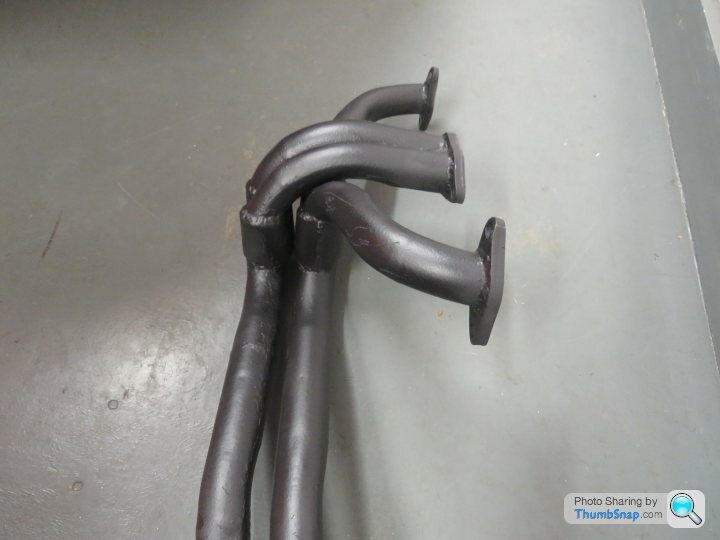Vixen exhaust manifold
Discussion
Hi,
I have a caterham Super Sprint engine|(Ford crossflow, so same size as the original engine) in the Vixen project I plan to restore, with no exhaust manifolds or exhaust system. I have sorted the exhaust system (being delivered new from JP Exhausts, Cheshire) but am struggling with the manifold.
I visited an Ebay seller local to me who had advertised a performance manifold and made a template that suggested it would fit once I had offered it up in the Vixen.So I purchased, but today I find the actual manifold in 3 dimensions will not fit. My question please is what would originally have been fitted, a standard Escort or Cortina setup maybe or something more tubuar, such as Mexico? Most importantly, what will fit?
I have a caterham Super Sprint engine|(Ford crossflow, so same size as the original engine) in the Vixen project I plan to restore, with no exhaust manifolds or exhaust system. I have sorted the exhaust system (being delivered new from JP Exhausts, Cheshire) but am struggling with the manifold.
I visited an Ebay seller local to me who had advertised a performance manifold and made a template that suggested it would fit once I had offered it up in the Vixen.So I purchased, but today I find the actual manifold in 3 dimensions will not fit. My question please is what would originally have been fitted, a standard Escort or Cortina setup maybe or something more tubuar, such as Mexico? Most importantly, what will fit?
.
This is the new one

See this thread
https://www.pistonheads.com/gassing/topic.asp?h=0&...
This is the one i took off which is on the shelf if you dont want a stainless one i had it checked and welded in a couple of spots so should be good for another few years



Andrew
This is the new one

See this thread
https://www.pistonheads.com/gassing/topic.asp?h=0&...
This is the one i took off which is on the shelf if you dont want a stainless one i had it checked and welded in a couple of spots so should be good for another few years



Andrew
Edited by Andrew Gray on Saturday 26th January 15:34
What Andrew says is correct, the standard manifold was a TVR specific unit. However you really want a manifold to match your exhaust pipe diameter and the power your engine is making.
The standard Vixen manifold is quite a small diameter pipe (1.75" iirc) as standard power was approx. 90bhp. Your Supersprint engine is probably making approx. 130 bhp so you'll want a larger diameter pipe to allow the gases out faster. You'll probably be wanting 2" (manifold and system) for the engine to breath properly.
If your JP pipe is 2" then don't go for a standard (1.75") Vixen manifold. You'll want to get one made by JP (or similar company) to suit. Then the standard unit can be improved on with a more free flowing design which will gain you up to another 10 bhp.
If your JP system is 1.75" then you may as well go for a standard Vixen unit but your engine will never deliver the performance it's capable of.
Moto
The standard Vixen manifold is quite a small diameter pipe (1.75" iirc) as standard power was approx. 90bhp. Your Supersprint engine is probably making approx. 130 bhp so you'll want a larger diameter pipe to allow the gases out faster. You'll probably be wanting 2" (manifold and system) for the engine to breath properly.
If your JP pipe is 2" then don't go for a standard (1.75") Vixen manifold. You'll want to get one made by JP (or similar company) to suit. Then the standard unit can be improved on with a more free flowing design which will gain you up to another 10 bhp.
If your JP system is 1.75" then you may as well go for a standard Vixen unit but your engine will never deliver the performance it's capable of.
Moto
Hi,
I hear what you are saying Moto about the need for a 2 inch system because of the higher output from the Super Sprint engine and I asked the guy at JP that exact question, He said the 1.75 inch system would suffice as their silencers are free flowing. Unsure now whether he gave the best advice but a bit late now to worry about it. It is a 1.75 inch system they have nade.
Andrew, are you suggesting your original manifold is available to buy? You could message me on jgear@blueyonder.co.uk with a reply if you like,
I hear what you are saying Moto about the need for a 2 inch system because of the higher output from the Super Sprint engine and I asked the guy at JP that exact question, He said the 1.75 inch system would suffice as their silencers are free flowing. Unsure now whether he gave the best advice but a bit late now to worry about it. It is a 1.75 inch system they have nade.
Andrew, are you suggesting your original manifold is available to buy? You could message me on jgear@blueyonder.co.uk with a reply if you like,
Moto said:
What Andrew says is correct, the standard manifold was a TVR specific unit. However you really want a manifold to match your exhaust pipe diameter and the power your engine is making.
The standard Vixen manifold is quite a small diameter pipe (1.75" iirc) as standard power was approx. 90bhp. Your Supersprint engine is probably making approx. 130 bhp so you'll want a larger diameter pipe to allow the gases out faster. You'll probably be wanting 2" (manifold and system) for the engine to breath properly.
If your JP pipe is 2" then don't go for a standard (1.75") Vixen manifold. You'll want to get one made by JP (or similar company) to suit. Then the standard unit can be improved on with a more free flowing design which will gain you up to another 10 bhp.
If your JP system is 1.75" then you may as well go for a standard Vixen unit but your engine will never deliver the performance it's capable of.
Moto
Interesting my engine was 138bhp when i last had it on a rolling road The standard Vixen manifold is quite a small diameter pipe (1.75" iirc) as standard power was approx. 90bhp. Your Supersprint engine is probably making approx. 130 bhp so you'll want a larger diameter pipe to allow the gases out faster. You'll probably be wanting 2" (manifold and system) for the engine to breath properly.
If your JP pipe is 2" then don't go for a standard (1.75") Vixen manifold. You'll want to get one made by JP (or similar company) to suit. Then the standard unit can be improved on with a more free flowing design which will gain you up to another 10 bhp.
If your JP system is 1.75" then you may as well go for a standard Vixen unit but your engine will never deliver the performance it's capable of.
Moto
Andrew
The O.D. of the primary tubes of my presumably original Vixen S2 manifold is 1 3/8".
The exhaust port on the head is just a wee, wee bit over 1".
The exhaust port on my ported Formula Ford head is 1.086".
One piece flange units you may purchase for an easier start for fabricating X-Flow headers come in at 35mm or 1 3/8".
There are many opinions and theories and perhaps, even hard scientifically proven facts about exhaust flow.
Here is one opinion:
First is the size of the primary tube. It is easy to assume the bigger the primary tube the better, but that's not the case.
The fact is, primary tubes that are too large actually cost you torque and horsepower by slowing down the rate at which the exhaust gases travel through the system. Think of your engine as an air pump. Every time the exhaust leaves the combustion chamber it is being forced into the primary tube for that cylinder.
Smaller diameter pipes flow less volume than larger ones, but the exhaust in the smaller pipe flows faster. Until you reach the RPM where the sheer volume of exhaust gases require bigger primary tube diameters, smaller tubes will scavenge the cylinders more efficiently. If you are using the engine at typical street-driven RPM's, you definitely want correctly fitted smaller primary tubes or you will lose a considerable amount of low end torque. Small tube headers do not lose their edge in horsepower and torque until you exceed 5,500-6,000 RPM.
So - unless you have a specialized and radically ported X-Flow head - what's the benefit of going to anything larger than 1 3/8" primaries?
Any thoughts on this thesis?
The exhaust port on the head is just a wee, wee bit over 1".
The exhaust port on my ported Formula Ford head is 1.086".
One piece flange units you may purchase for an easier start for fabricating X-Flow headers come in at 35mm or 1 3/8".
There are many opinions and theories and perhaps, even hard scientifically proven facts about exhaust flow.
Here is one opinion:
First is the size of the primary tube. It is easy to assume the bigger the primary tube the better, but that's not the case.
The fact is, primary tubes that are too large actually cost you torque and horsepower by slowing down the rate at which the exhaust gases travel through the system. Think of your engine as an air pump. Every time the exhaust leaves the combustion chamber it is being forced into the primary tube for that cylinder.
Smaller diameter pipes flow less volume than larger ones, but the exhaust in the smaller pipe flows faster. Until you reach the RPM where the sheer volume of exhaust gases require bigger primary tube diameters, smaller tubes will scavenge the cylinders more efficiently. If you are using the engine at typical street-driven RPM's, you definitely want correctly fitted smaller primary tubes or you will lose a considerable amount of low end torque. Small tube headers do not lose their edge in horsepower and torque until you exceed 5,500-6,000 RPM.
So - unless you have a specialized and radically ported X-Flow head - what's the benefit of going to anything larger than 1 3/8" primaries?
Any thoughts on this thesis?
tyracious said:
The O.D. of the primary tubes of my presumably original Vixen S2 manifold is 1 3/8".
The exhaust port on the head is just a wee, wee bit over 1".
The exhaust port on my ported Formula Ford head is 1.086".
One piece flange units you may purchase for an easier start for fabricating X-Flow headers come in at 35mm or 1 3/8".
There are many opinions and theories and perhaps, even hard scientifically proven facts about exhaust flow.
Here is one opinion:
First is the size of the primary tube. It is easy to assume the bigger the primary tube the better, but that's not the case.
The fact is, primary tubes that are too large actually cost you torque and horsepower by slowing down the rate at which the exhaust gases travel through the system. Think of your engine as an air pump. Every time the exhaust leaves the combustion chamber it is being forced into the primary tube for that cylinder.
Smaller diameter pipes flow less volume than larger ones, but the exhaust in the smaller pipe flows faster. Until you reach the RPM where the sheer volume of exhaust gases require bigger primary tube diameters, smaller tubes will scavenge the cylinders more efficiently. If you are using the engine at typical street-driven RPM's, you definitely want correctly fitted smaller primary tubes or you will lose a considerable amount of low end torque. Small tube headers do not lose their edge in horsepower and torque until you exceed 5,500-6,000 RPM.
So - unless you have a specialized and radically ported X-Flow head - what's the benefit of going to anything larger than 1 3/8" primaries?
Any thoughts on this thesis?
You are not considering the need for the bigger is better theorum down the pub The exhaust port on the head is just a wee, wee bit over 1".
The exhaust port on my ported Formula Ford head is 1.086".
One piece flange units you may purchase for an easier start for fabricating X-Flow headers come in at 35mm or 1 3/8".
There are many opinions and theories and perhaps, even hard scientifically proven facts about exhaust flow.
Here is one opinion:
First is the size of the primary tube. It is easy to assume the bigger the primary tube the better, but that's not the case.
The fact is, primary tubes that are too large actually cost you torque and horsepower by slowing down the rate at which the exhaust gases travel through the system. Think of your engine as an air pump. Every time the exhaust leaves the combustion chamber it is being forced into the primary tube for that cylinder.
Smaller diameter pipes flow less volume than larger ones, but the exhaust in the smaller pipe flows faster. Until you reach the RPM where the sheer volume of exhaust gases require bigger primary tube diameters, smaller tubes will scavenge the cylinders more efficiently. If you are using the engine at typical street-driven RPM's, you definitely want correctly fitted smaller primary tubes or you will lose a considerable amount of low end torque. Small tube headers do not lose their edge in horsepower and torque until you exceed 5,500-6,000 RPM.
So - unless you have a specialized and radically ported X-Flow head - what's the benefit of going to anything larger than 1 3/8" primaries?
Any thoughts on this thesis?
 Its funny but I read this post a few months ago and was going to comment but decided I couldn't be arsed.... What I do know is my 5.0 ford V8 has about 300hp and its Primaries are pretty damn tiny
Its funny but I read this post a few months ago and was going to comment but decided I couldn't be arsed.... What I do know is my 5.0 ford V8 has about 300hp and its Primaries are pretty damn tiny  I may need to upgrade to crossflow sizes
I may need to upgrade to crossflow sizes 
N.
I think the figure of 1-3/8" primary ID *is* for highly tuned engines, but probably not race tuned. I don't think 2" has been mentioned as a primary diameter, just as a tail pipe diameter.
If you have your valve timing etc. numbers handy, there's this calculator as a starting point:
http://www.mezporting.com/exhaust_length.html
Interesting that induction length is also a factor. Something else to play with I suppose, but there's very little room for longer RAM pipes.
Also:
"A reduction in primary pipe Diameter of 1/8 of an inch will move the torque peak down by 650-800 RPM. Conversely an increase in diameter of the header will raise the engine speed at which max torque occurs,by approx the same RPM,for each 1/8 of increase."
"Adding length to the primary pipe will increase low speed and mid-range power, with corresponding reduction in power at max RPM.
Shorter primaries give an increase in high speed power, at the expense of reduction in the midrange. However,there will be little change in peak torque or the engine speed at which it occurs."
I've taken a few quick measurements on my 1600M *definitely* original manifold. Primaries are <1.2" OD, secondaries are 1.5" OD going into 1.75" tail pipe. Mine appears to be a later design with shorter primary and secondary lengths.
Without knowing TVR's design parameters it's hard to guess, but it could be that the later design is somewhat better (narrower primaries moving max torque lower and shorter pipe lengths giving more power at high revs), or it could be that it was just cheaper to make and made no real difference to performance on a standard engine either way. Probably the latter
If you have your valve timing etc. numbers handy, there's this calculator as a starting point:
http://www.mezporting.com/exhaust_length.html
Interesting that induction length is also a factor. Something else to play with I suppose, but there's very little room for longer RAM pipes.
Also:
"A reduction in primary pipe Diameter of 1/8 of an inch will move the torque peak down by 650-800 RPM. Conversely an increase in diameter of the header will raise the engine speed at which max torque occurs,by approx the same RPM,for each 1/8 of increase."
"Adding length to the primary pipe will increase low speed and mid-range power, with corresponding reduction in power at max RPM.
Shorter primaries give an increase in high speed power, at the expense of reduction in the midrange. However,there will be little change in peak torque or the engine speed at which it occurs."
I've taken a few quick measurements on my 1600M *definitely* original manifold. Primaries are <1.2" OD, secondaries are 1.5" OD going into 1.75" tail pipe. Mine appears to be a later design with shorter primary and secondary lengths.
Without knowing TVR's design parameters it's hard to guess, but it could be that the later design is somewhat better (narrower primaries moving max torque lower and shorter pipe lengths giving more power at high revs), or it could be that it was just cheaper to make and made no real difference to performance on a standard engine either way. Probably the latter

Gassing Station | TVR Classics | Top of Page | What's New | My Stuff



